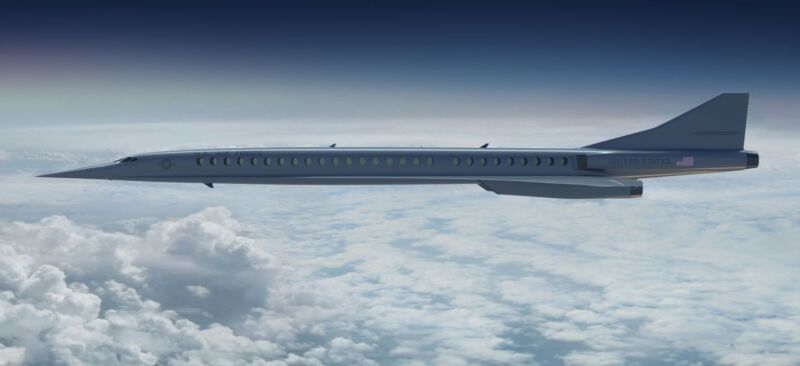
The US military has indicated its interest in commercial supersonic flight by granting as much as $60 million to Boom Supersonic for its airliner development efforts.
The Colorado-based company has announced that the Air Force awarded a three-year contract to Boom to accelerate research and development of its Overture airliner. Separately this week, Boom selected Piedmont Triad International Airport in Greensboro, North Carolina, as the site of its first full-scale manufacturing facility. There, Boom plans to begin production in 2024, with the first Overture aircraft slated to roll out in 2025, fly in 2026, and carry its first passengers by 2029.
Boom is designing Overture to carry between 65 and 88 passengers at subsonic speeds over land and supersonic speeds over water—more than twice as fast as current commercial aircraft. The aircraft is designed to operate on 100 percent “sustainable” fuels, and the company says the vehicle will be net-zero carbon from day one.
The Air Force is interested in the technology for rapid global travel and logistics, with potential applications such as executive transport, special operations, and reconnaissance. The Air Force is making this investment through its AFWERX program, which seeks to foster innovation within the military and bring commercial technologies to operational status more quickly. The funding for Boom, known as a Strategic Funding Increase (or STRATFI), represents a sizable bet on supersonic aviation.
“With STRATFI, we’re able to collaborate with the Air Force on the unique requirements and needs for global military missions, ultimately allowing Boom to better satisfy the needs of the Air Force where it uses commercially derived aircraft,” Boom founder and CEO Blake Scholl said in a news release. “As a potential future platform for the Air Force, Overture would offer the valuable advantage of time, an unmatched option domestically and internationally.”
The government funding also represents a timely vote of confidence for Boom, which is among a number of startup companies working to develop supersonic aircraft for commercial passenger service. The money could help Boom raise additional private capital to fully fund Overture, which will require an enormous upfront investment. Boom estimates it will take $6 to $8 billion to develop Overture.
Despite two high-profile attempts last century, supersonic flight for commercial air travel has been dead for about two decades. The Soviet Tupolev supersonic aircraft flew just a few dozen commercial flights back in 1977, and the Concorde, flown by British Airways and Air France beginning in 1976, retired in 2003 after economic problems were compounded by a fatal accident in 2000.
Now, with a combination of new technologies, private capital, and efforts by NASA and others to study ways to dilute the impact of sonic booms over land, interest in supersonic commercial travel has been renewed. Outsiders, on the other hand, may have a hard time seeing past all the PR and renderings to know which companies might actually bring an aircraft into service.
The US Air Force presumably has better access to pertinent data, and now it has made a sizable bet on Boom. In turn, Boom is putting down manufacturing roots in a state where powered aircraft first took flight. Perhaps a new generation of commercial supersonic air travel will become a reality after all.
